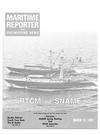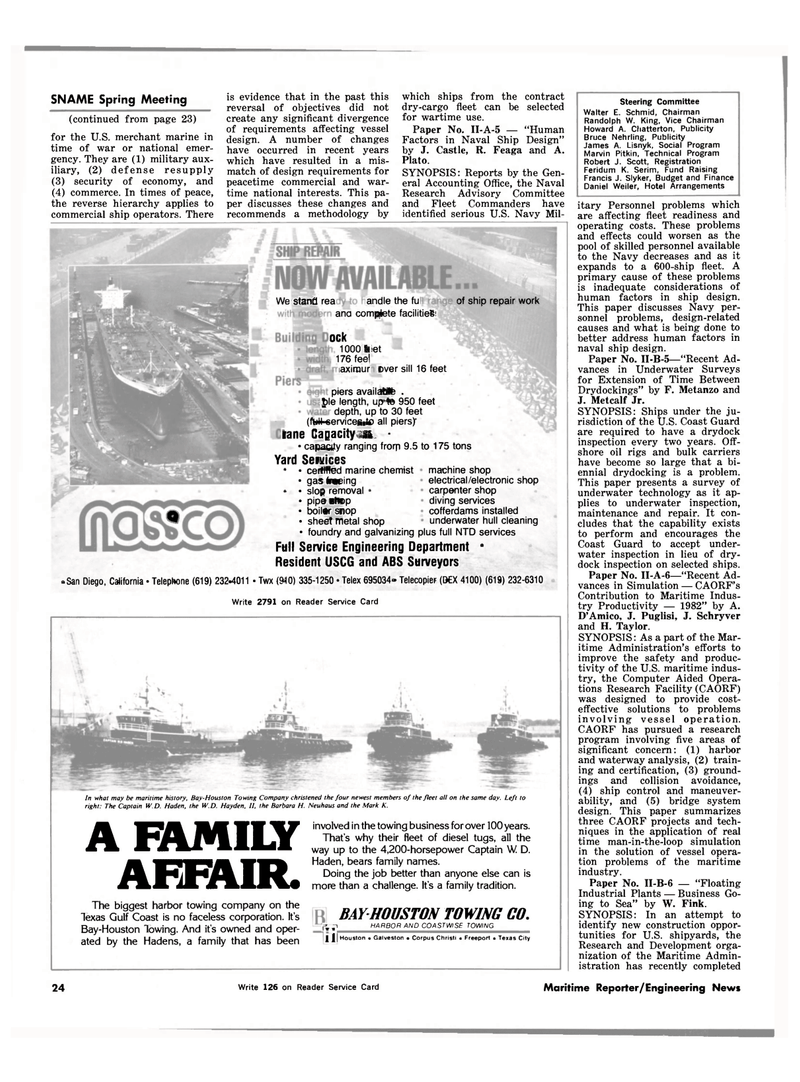
Page 24: of Maritime Reporter Magazine (March 15, 1983)
Read this page in Pdf, Flash or Html5 edition of March 15, 1983 Maritime Reporter Magazine
SNAME Spring Meeting (continued from page 23) for the U.S. merchant marine in time of war or national emer- gency. They are (1) military aux- iliary, (2) defense resupply (3) security of economy, and (4) commerce. In times of peace, the reverse hierarchy applies to commercial ship operators. There is evidence that in the past this reversal of objectives did not create any significant divergence of requirements affecting vessel design. A number of changes have occurred in recent years which have resulted in a mis- match of design requirements for peacetime commercial and war- time national interests. This pa- per discusses these changes and recommends a methodology by which ships from the contract dry-cargo fleet can be selected for wartime use.
Paper No. II-A-5 — "Human
Factors in Naval Ship Design" by J. Castle, R. Feaga and A.
Plato.
SYNOPSIS: Reports by the Gen- eral Accounting Office, the Naval
Research Advisory Committee and Fleet Commanders have identified serious U.S. Navy Mil-
Steering Committee
Walter E. Schmid, Chairman
Randolph W. King, Vice Chairman
Howard A. Chatterton, Publicity
Bruce Nehrling, Publicity
James A. Lisnyk, Social Program
Marvin Pitkin, Technical Program
Robert J. Scott, Registration
Feridum K. Serim, Fund Raising
Francis J. Slyker, Budget and Finance
Daniel Weiler, Hotel Arrangements itary Personnel problems which are affecting fleet readiness and operating costs. These problems and effects could worsen as the pool of skilled personnel available to the Navy decreases and as it expands to a 600-ship fleet. A primary cause of these problems is inadequate considerations of human factors in ship design.
This paper discusses Navy per- sonnel problems, design-related causes and what is being done to better address human factors in naval ship design.
Paper No. II-B-5—"Recent Ad- vances in Underwater Surveys for Extension of Time Between
Drydockings" by F. Metanzo and
J. Metcalf Jr.
SYNOPSIS: Ships under the ju- risdiction of the U.S. Coast Guard are required to have a drydock inspection every two years. Off- shore oil rigs and bulk carriers have become so large that a bi- ennial drydocking is a problem.
This paper presents a survey of underwater technology as it ap- plies to underwater inspection, maintenance and repair. It con- cludes that the capability exists to perform and encourages the
Coast Guard to accept under- water inspection in lieu of dry- dock inspection on selected ships.
Paper No. II-A-6—"Recent Ad- vances in Simulation — CAORF's
Contribution to Maritime Indus- try Productivity — 1982" by A.
D'Amico, J. Puglisi, J. Schryver and H. Taylor.
SYNOPSIS: As a part of the Mar- itime Administration's efforts to improve the safety and produc- tivity of the U.S. maritime indus- try, the Computer Aided Opera- tions Research Facility (CAORF) was designed to provide cost- effective solutions to problems involving vessel operation.
CAORF has pursued a research program involving five areas of significant concern: (1) harbor and waterway analysis, (2) train- ing and certification, (3) ground- ings and collision avoidance, (4) ship control and maneuver- ability, and (5) bridge system design. This paper summarizes three CAORF projects and tech- niques in the application of real time man-in-the-loop simulation in the solution of vessel opera- tion problems of the maritime industry.
Paper No. II-B-6 — "Floating
Industrial Plants — Business Go- ing to Sea" by W. Fink.
SYNOPSIS: In an attempt to identify new construction oppor- tunities for U.S. shipyards, the
Research and Development orga- nization of the Maritime Admin- istration has recently completed
In what may be maritime history, Bay-Houston Towing Company christened the four newest members of the fleet all on the same day. Left to right: The Captain W.D. Haden, the W.D. Hayden, II, the Barbara H. Neuhaus and the Mark K.
A FAMILY
AFFAIR.
The biggest harbor towing company on the
Texas Gulf Coast is no faceless corporation. It's
Bay-Houston "lowing. And it's owned and oper- ated by the Hadens, a family that has been involved in the towing business for over 100 years.
That's why their fleet of diesel tugs, all the way up to the 4,200-horsepower Captain W. D.
Haden, bears family names.
Doing the job better than anyone else can is more than a challenge. It's a family tradition.
BAY HOUSTON TOWING CO. , -l HARBOR AND COASTWISE TOWING |j[ Houston • Galveston • Corpus Christi • Freeport • Texas City
We stand rea andle the fu ana complete facilities: ock 1000f< 176 feej laxiraur iet of ship repair work
Over sill 16 feet piers availaHfc . >le length, up te 950 feet depth, up to 30 feet (fi*«ervices to all piers)1 lane Capacity s - • capacity ranging frorp 9.5 to 75 tons
Yard Services * • certified marine chemist • gas-treeing • • slop removal - • pipe shop • boilflnop • sheet metal shop • foundry and galvanizing plus full NTD services
Full Service Engineering Department °
Resident USCG and ABS Surveyors oSan Diego, California • Telephone (619) 232-4011 • Twx (WO) 335-1250 • Telex 695034» Telecopier (OCX 4100) (619) 232-6310
Q machine shop electrical/electronic shop carpenter shop diving services cofferdams installed underwater hull cleaning
Write 2791 on Reader Service Card 24 Write 126 on Reader Service Card Maritime Reporter/Engineering News

 23
23

 25
25
